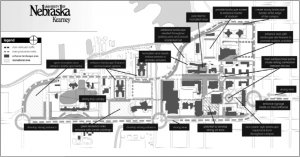Renee Ballenger
Editor
 UNK’s comprehensive Facilities Development Plan is supplemented by a Utility Master Plan and a Landscaping Master Plan, and within these guidelines are immediate initiatives that involve adding some 150 new trees to the campus in the next year.
UNK’s comprehensive Facilities Development Plan is supplemented by a Utility Master Plan and a Landscaping Master Plan, and within these guidelines are immediate initiatives that involve adding some 150 new trees to the campus in the next year.
Forward-looking, and written in consultation with Sinclair/Hille Architects, this document is helping guide UNK’s facilities team in the design and maintenance of a vibrant, quality campus that will continue to attract students and employees into the future.
The landscape plan proposes the molding of an enlivened place where people can interact, and the preservation of significant features that bring a rich sense of place and tradition. The result will be the gradual unfolding of a cohesive campus image that is aesthetically pleasing and conducive to the pursuit of higher education and campus community.
The landscape goals include the creation of an elaborate but unified view of the natural environment on campus by way of a thorough assessment of the condition of existing campus plant materials. For instance, a review of the campus landscape was conducted to determine where screening (the placement of plant material to screen otherwise poor views, such as parking lots, and accentuate advantageous ones) should be incorporated. Also, “the edge” of the university—where the heart of the university physically begins—will be defined with various landscape design elements. UNK’s Landscape Master Plan identifies entrances—literal and figurative—that deliberately set the tone of a campus that is comfortable, safe, engaging and abundant with recreational opportunities, gathering spaces and sanctuary for mental stimulation.
The landscape plan actually spans over a 10-year period with milestone development goals set for this fall, within three years, within five years and within 10 years. Associated elements in the palette of UNK’s landscape plan include lighting, furnishings, signage design plans, but certainly one of the most promising and enduring roles is that of the trees.
By mid-fall (the optimum time for planting UNK’s trees) of this year, this “friendship” will be deeply nurtured with a project to set about 150 new trees across campus–efforts at a value of more than $70,000. The facilities team has been working closely with the Department of Biology and the Nebraska Statewide Arboretum to choose trees and other flora that will best thrive in this area of the state,” said Lee McQueen, UNK director of facilities. One of the primary benefits of this project will be the ability to set trees with more maturity, some ranging from six to eight inches in diameter.
In the last two years, 84 of these “friends” on campus have been impacted by the ice storm of Winter 2006, and the current residential hall and utility construction. As a result of these events, 39 trees were removed and 45 trees were relocated or protected on site. Relocation was delicate and purposeful. To illustrate,McQueen points out how it was beneficial to their environment that some of the conifers relocated in the West Center area were planted together, not alone, and intentionally spaced. “It is in these types of concepts where the expertise of biology and the arboretum is such a benefit to us,”McQueen said. Incidentally, another friend that may have been recognized by campus walkers-by, is the Gingko tree now standing west of the West Center, relocated from the south portion of the Nester project. “Besides the 150 trees included in the fall project,” McQueen adds, “30 to 50 trees, and a wide variety of flowers, shrubbery and indigenous grasses will be planted around Antelope and Nester Halls.”
Precise and prolific landscape design is no simple task. Principles such as context, environment, spatiality, scale, massing, (the best view achieved through planting in a mass of three or more), combinations, balance, texture, color, and repetition and patterns, are just some of the both scientific and artful considerations. Not to mention the ever-mindful infrastructure and safety issues like the presence of utilities, sprinkler systems and foot traffic paths. “There is a synergy to be reached in the combination of all the natural plant materials and the human’s infrastructure needs,”McQueen said.
“However, we are not building Disneyland here, as we are not staffed for that kind of daily maintenance, and we want to develop campus landscaping materials that are interesting yearround, not just what looks good in spring.”
Philosophically speaking then, McQueen would affirm that UNK’s Landscape Master Plan is, indeed, Shakespearean in intent. The Mission of the Plan states the desire to: “Speak to hearts and minds of students—prospective and current and even, alumni. . . (and) balance(s) the need for strong aesthetics in the traditional campus style with functional requirements of spaces that can accommodate all activities of the student body,”–emphatically suggesting that fulfillment of the landscaping goals will even complement teaching. McQueen agrees wholeheartedly. “Biology teaching implications, for example, will certainly be integral in the selection process of flora. A diversity of vegetation will be available right on the campus grounds for study.”
The vision statement in the Facilities Development Plan recognizes the need to “establish an image of solid, timeless education that is sensitive to the individual needs of students.” Further, it implies that a “campus landscape shall promote excellence in design, beauty, and function; provide opportunities for sharing and learning; and create a rich sense of place for the enrichment of all who see and use it.” Delightfully, this will be achieved in part under the friendly arms of hundreds of new trees.